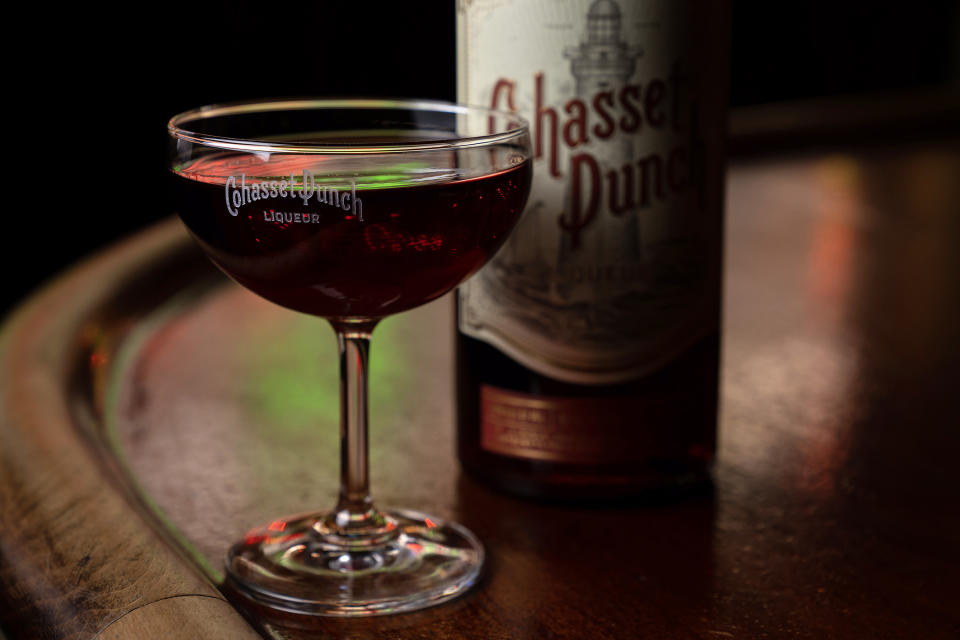Want to party like it’s 1899? One Chicagoan is working to revive Cohasset Punch liqueur
CHICAGO -- In mid-20th-century Chicago, walking along the 200 block of West Madison Street in Chicago, you could not help but notice the big sign with the colorful neon lighthouse and the words “Home of Cohasset Punch.” This eye-catching image hung over the sidewalk in front of the Ladner Bros. tavern. The old-timey bar was just one of many local places — including legends like Don Roth’s Blackhawk and Chez Paree — where you could sip a Cohasset Punch cocktail.
As reported in Bonfort’s Wine and Spirits Circular in 1902, Cohasset Punch was created by mixologist Thomas Newman, a business partner of Lewis Williams. The two owned the Williams & Newman saloon. According to one story, while at a get-together in Cohasset, Massachusetts, Williams wired Newman and asked him to prepare a drink that would “surpass anything ever before imbibed by any living soul.” Newman sent a barrel by railcar to Massachusetts, and he dubbed the stuff Cohasset Punch. Another version of the story relates that Williams himself created the punch at the Cohasset party and brought it back to Chicago. This was in early 1899; by fall of that year, they were bottling and selling Cohasset Punch in Chicago, apparently an instant hit.
Ingrained in Chicago culture, Cohasset Punch was referenced in “Dangling Man,” the debut novel from Nobel and Pulitzer Prize-winning author Saul Bellow. It was said to be a favorite of George “Papa Bear” Halas, whose Chicago Bears office was right down the street from the “Home of Cohasset Punch,” the iconic sign that would likely be recognized by many longtime Chicagoans. Bonfort’s noted that demand for Cohasset Punch in Chicago was so high at one point that “what the mint julep is to the South, Cohasset Punch is to Chicago.”
So, what was Cohasset Punch like? The brilliant ruby red drink delivers a lot of flavors like stone fruit, perhaps some citrus and raisins. According to a reference in the Chicago Tribune in Aug. 17, 1938, after three or four of them, “a pleasant mellowness steals over you, your imagination glows, you discover humor you never possessed. Then suddenly you push your chair back to stand up, and lo, your legs are merely attached to your body for appearances’ sake!”
Williams and Newman opened a new location for their tavern on West Madison Street in 1915, and they retired one year later. The rights to Cohasset Punch passed to the “Ladner Bros,” two German-born barkeepers who had just established a Chicago outpost of their saloon and wholesale liquor business next door to the Williams & Newman saloon on Madison. Though business took a hit during Prohibition, Cohasset Punch came back strong in the 1930s. By 1989, however, production of Cohasset Punch halted, and shortly thereafter, the trademark expired.
Just a few years ago, Greg Shutters, graphic designer and cocktail historian, purchased the trademark and vowed to return Cohasset Punch to Chicago. “I’m a very passionate person,” Shutters said. “I’m one of those people driven by intense interests in, for instance, graphic design, history and spirits. Cohasset Punch was a big intersection of all those intense interests.”
Based on historical documentation, Shutters recreated the taste of Cohasset Punch. It was not always easy.
In 1901, the recipe for making Cohasset Punch from scratch was reported in J.E. Sheridan’s “The Complete Buffet Manual,” which specified a jigger each of New England rum and sweet vermouth, the juice of one-half lemon, a dash of orange bitters and simple syrup.
“My first experiments in 2019,” Shutters recalled, “used the 1901 recipe as a jumping-off point. I then figured out rough proportions and filled in gaps by consulting recipes using similar ingredients published in 19th and early-20th century bartenders’ and distillers’ manuals.”
Some original ingredients were no longer available. The New England rum called for in the recipe, for instance, is out of production. So, Shutters had to blend rums from the Virgin Islands, Trinidad and Jamaica to approximate what he believed to be the flavor of that now defunct East Coast rum.
“One of the things that intrigued me most about Cohasset Punch was that it was a very well-branded product from the 1890s all the way up to its final iteration in the late 1980s,” Shutters said. “Every bottle had this picture of the lighthouse off Cohasset, Massachusetts, and that image was on bottles of Cohasset Punch for almost 100 years. And then there was that beautiful old sign outside the bar. Bringing back Cohasset Punch has been a dream come true.”
Shutters has completed a first bottling run using a bottler in Fort Wayne, Indiana, and plans to have Cohasset Punch on liquor store shelves this spring.
There are also several simple recipes for preparing a cocktail with Cohasset Punch. Some prefer to pour chilled Cohasset Punch into a coupe cocktail glass containing a peach slice marinated in brandy. Other recipes suggest splashing in some canned peach juice. If you want to keep it simple, however, just add an ounce or so of Cohasset Punch to a chilled white wine and voilà: a Cohasset Royale. For a Cohasset Highball, add Cohasset Punch to ginger ale or seltzer. You might even consider using it in place of Aperol or Campari in a spritz.
You don’t, however, really need to add a lot to Cohasset Punch to make a delicious drink. It’s a refreshing sip, and similar to Malört, its more intense cousin, Cohasset Punch is a taste of old Chicago.



